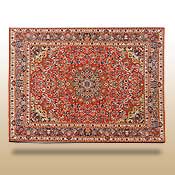

Follow this step-by-step process to become an expert on how to store rugs:
Step 1: Give your rug a thorough clean
Step 2: Roll up your rug and secure it with twine
Step 3: Wrap your rug in Tyvek
Step 4: Choose the right storage space
Step 5: Place the rug in a high-position in your storage space
Step 6: Check up on your rug regularly.
Step 1: Give Your Rug a Thorough Clean
Over time all dirt, dust and debris will have nestled into the fibres of your rug. If you wrap and store your rug whilst it is still dirty, all that dirt, dust and debris will be deeply ingrained; you’ll have little chance of ridding your rug of the stains and odours likely to follow. What’s worse is that some dirt and debris can cause dry rot, or even mould, which are certain to permanently damage your rug. Step one in how to store a rug is: always give it a thorough clean. This should include a vacuum, followed by the use of upholstery cleaner, and then another vacuum.
In addition, there’s every chance that tiny bugs and insects have made your rug their home. To get rid of these invisible creepy-crawlies, simply pop your rug out in the sun for the day. The sunlight will kill most insects.
Step 2: Roll Up Your Rug and Secure It with Twine
Rugs should always be rolled so that they face outwards. While rolling a rug face-in might help protect their surface, it actually puts far too much pressure on the backing and the glue that holds them altogether. When knowing how to roll a rug for storage, keep in mind that you don’t want to roll it too tightly. If you do, you can weaken the backing and the glue, and cause the rug to curl up once you try to unroll it.
Once you’ve got your rug rolled, you need to acquaint yourself with twine. Twine is the perfect material for securing your rolled-up rug. It keeps your rug all rolled up, without being abrasive or placing too much pressure on its surface.
In a pinch, you can use a piece of rope in place of twine, but just make sure that the fibres of the rope are soft enough that they won’t rub or wear against the rug.
Step 3: Wrap Your Rug in Tyvek
Once the rug has been completely cleaned, insect-treated, rolled and secured, it’s time to wrap it. The best material to wrap a rug that will be stored long-term is white Tyvek paper. A synthetic material, Tyvek paper will provide protection against dust and pests, while still allowing the rug to breath, prevent it from becoming musty and mouldy. This step is especially important if you want to understand how to store Persian rugs. Tyvek paper is the ultimate wrapping material in this instance, given the precious fibres used in weaving a Persian rug.
Step 4: Choose the Right Storage Space
When choosing a storage space, you need to find somewhere that is climate-controlled and protected from dust and pests. Sudden fluctuations in temperature will wreak havoc with the fibres that make up your rug and, no matter how well protected your rug is, huge influxes of dust and pests will have an effect. Not surprisingly, garages, attics and basements are among the worst places to store your rugs. So, if you can’t find an appropriate space to store your rug within your home, you might want to consider a professional storage space.
Step 5: Place the Rug in a High Position in Your Storage Space
Now that you’ve found exactly the right storage space, you need to know where you rug belongs within that space. The best way to store rugs is up high, with nothing stacked on top of them. Placing your rug in an elevated position will protect it from any moisture that may seep into the space. If it’s up high, it’s unlikely that anything will fall onto your rug, squashing its fibres and damaging its backing.
Step 6: Check on Your Rug Regularly
If you’ve opted for a professional storage space, and followed all the instructions above, then your rug should remain safe and sound inside your storage unit.
Just follow these six easy to follow steps and you’ve learned how to store rugs.
